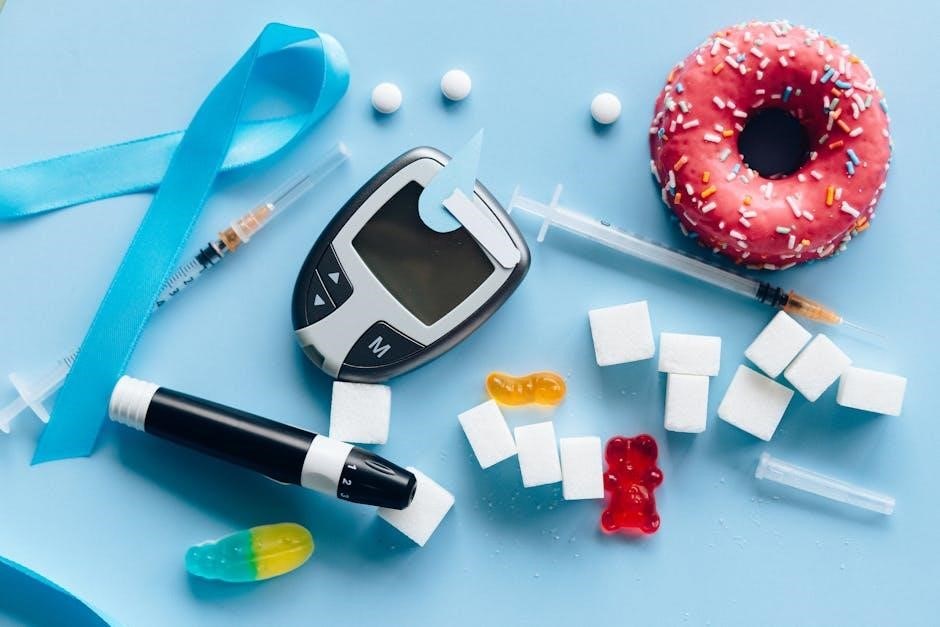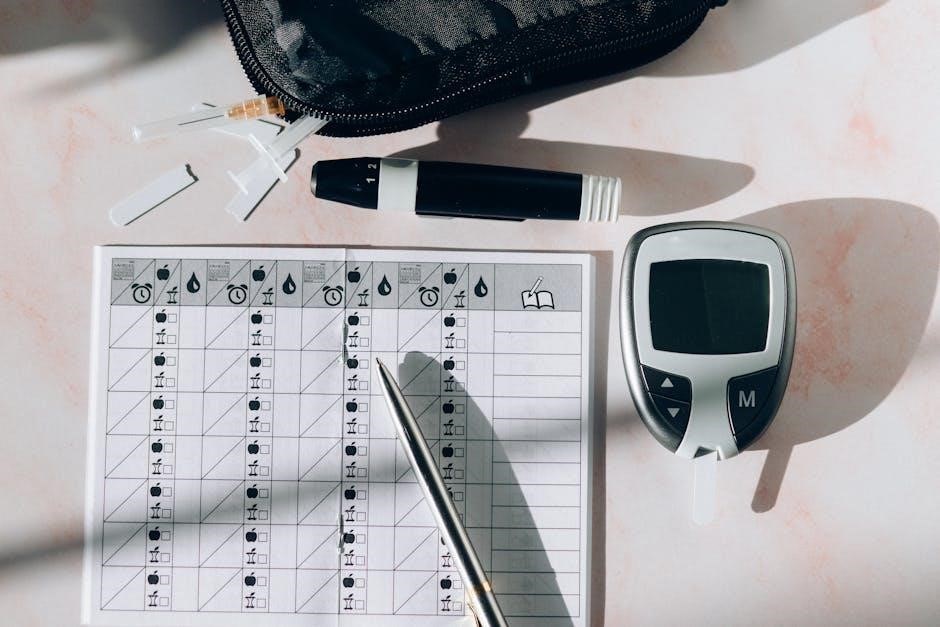Eat to Beat Disease: A Comprehensive Plan
Discover valuable PDF resources, including a free shopping guide and a comprehensive workbook, designed to help you implement Dr; Li’s strategies effectively.
Paramount Press offers a 29MB workbook, while Dr. Li’s guide, organized like a supermarket, simplifies health-boosting food selection for daily integration.

Explore these tools to unlock the power of food as medicine and enhance your body’s natural defenses, as detailed in Eat to Beat Disease.
The “Eat to Beat Disease” concept, popularized by Dr. William Li, represents a paradigm shift in how we approach health and wellness. It moves beyond simply treating symptoms to actively harnessing the body’s inherent healing capabilities through strategic dietary choices.
Central to this philosophy is the understanding that our bodies possess five powerful defense systems – angiogenesis, stem cell activation, the microbiome, the immune system, and DNA protection – all of which can be significantly influenced by the foods we consume.
Dr. Li’s research, detailed in his book and accompanying PDF resources like the workbook from Paramount Press and the free shopping guide, reveals that specific foods can activate these defenses, potentially preventing or even reversing chronic diseases.
These readily available resources, including the mobile-friendly shopping guide, empower individuals to translate scientific findings into practical, everyday dietary habits. The concept isn’t about restrictive dieting, but rather about intelligently selecting foods that work with your body to promote optimal health and resilience.
Ultimately, “Eat to Beat Disease” offers a proactive, food-as-medicine approach to long-term well-being.
Dr. William Li and His Research
Dr. William Li is a physician, scientist, and author renowned for his groundbreaking research on the relationship between food and health. His work centers on identifying compounds within common foods that activate the body’s five natural defense systems.
Li’s investigations, culminating in his book Eat to Beat Disease, challenge conventional medical wisdom by demonstrating how dietary choices can profoundly impact disease prevention and treatment. He doesn’t focus on single nutrients, but rather on the synergistic effects of whole foods.
Supporting his book, Dr. Li provides accessible PDF resources, including a free shopping guide designed for practical implementation. This guide, mirroring supermarket layouts, simplifies the process of selecting health-boosting foods.
Furthermore, a detailed workbook, available from Paramount Press, offers a deeper dive into the concepts presented in his research, aiding readers in personalizing their dietary strategies. His podcast appearances also highlight the potential of food as medicine.
Dr. Li’s work empowers individuals to take control of their health through informed food choices, backed by rigorous scientific evidence.

The Five Defense Systems of the Body
Dr. William Li’s research identifies five crucial defense systems within the human body, all of which can be activated through specific dietary choices. These systems are angiogenesis, stem cell activation, the microbiome, the immune system, and DNA protection.
His book, Eat to Beat Disease, details how foods can influence each system, offering a new perspective on preventative healthcare. Understanding these systems is key to leveraging food as medicine, as highlighted in his work and accompanying PDF resources;
The free shopping guide provided by Dr. Li categorizes foods based on which defense system they primarily support, simplifying the selection process. The workbook expands on this, offering detailed strategies for dietary integration.
By strategically incorporating foods that target these systems, individuals can bolster their body’s natural ability to heal and resist disease. This holistic approach, detailed in his research, moves beyond symptom management.
Ultimately, Li’s work demonstrates the profound impact of nutrition on overall health and resilience, offering a proactive path to wellness.
Angiogenesis and Food’s Role
Angiogenesis, the formation of new blood vessels, is a critical defense system targeted by Dr. Li’s research. He demonstrates how certain foods can either promote or inhibit angiogenesis, impacting health outcomes.
Specifically, foods that inhibit angiogenesis can starve cancer cells, while promoting it supports wound healing and tissue regeneration. Eat to Beat Disease details these nuanced effects, offering a food-based approach to managing these processes.
The accompanying PDF resources, including the shopping guide, categorize foods based on their angiogenic properties, making informed choices easier. Tomatoes, berries, and dark chocolate are examples of angiogenesis-modulating foods.
Dr. Li’s work emphasizes that angiogenesis isn’t inherently good or bad; it’s the context that matters. The workbook provides strategies for leveraging this understanding to optimize health.
By understanding how food impacts angiogenesis, individuals can proactively influence their body’s vascular health and potentially mitigate disease risk.
Stem Cell Activation Through Diet

Dr. William Li’s research highlights the remarkable potential of dietary choices to activate the body’s stem cells, crucial for tissue repair and regeneration. Eat to Beat Disease details how specific foods can signal stem cells to wake up and perform their restorative functions.
The PDF workbook expands on this concept, providing practical guidance on incorporating stem cell-activating foods into daily meals. These foods aren’t about replacing damaged cells, but rather prompting the body’s own repair mechanisms.
Foods like green tea, dark chocolate, and certain berries contain compounds that stimulate stem cell activity in different organs. The shopping guide simplifies identifying these beneficial ingredients.
Li emphasizes that stem cell activation is a natural process that can be significantly enhanced through nutrition. This isn’t about stem cell therapy, but rather dietary support for existing stem cells.
Utilizing the resources, individuals can learn to nourish their stem cells and bolster their body’s inherent capacity for self-renewal and healing.
The Microbiome and its Impact on Health
Dr. William Li’s Eat to Beat Disease underscores the critical role of the gut microbiome in overall health and disease prevention. A thriving microbiome strengthens the body’s defenses and influences numerous physiological processes.
The accompanying PDF resources, including the workbook, detail how dietary choices directly impact the composition and function of the gut microbiome. Specific foods act as prebiotics, nourishing beneficial bacteria.
Foods rich in fiber, polyphenols, and fermented compounds promote a diverse and balanced gut ecosystem. This, in turn, enhances immune function, nutrient absorption, and even mental well-being;
Li’s research reveals that a healthy microbiome isn’t just about what you eat, but feeding the right microbes. The shopping guide aids in selecting foods that support microbial diversity.

By leveraging the information within the PDF materials, individuals can cultivate a robust microbiome and unlock its profound benefits for long-term health and resilience.
Immune System Enhancement with Nutrition

Dr. William Li’s Eat to Beat Disease highlights how strategic nutrition can dramatically bolster the immune system’s ability to defend against illness and disease. The PDF workbook expands on this, offering practical guidance.
The core principle revolves around consuming foods that activate and strengthen various components of immune function. Specific nutrients and phytochemicals found in certain foods directly enhance immune cell activity.
The free shopping guide PDF simplifies identifying these immune-boosting foods at the grocery store, categorizing them for easy access. Foods like berries, mushrooms, and green tea are emphasized;
Li’s research demonstrates that a well-nourished immune system is more responsive and effective at identifying and neutralizing threats. This proactive approach is central to his philosophy.
Utilizing the insights from the PDF resources, individuals can create a dietary plan that actively supports and strengthens their immune defenses, promoting overall health and resilience.
DNA Protection and Dietary Choices
Dr. William Li’s Eat to Beat Disease emphasizes the critical role of nutrition in safeguarding DNA integrity, a cornerstone of long-term health. The accompanying PDF resources provide actionable strategies.
The book details how certain foods contain compounds that protect DNA from damage caused by oxidative stress and inflammation – key drivers of aging and disease. This protection is vital for cellular health.
The free shopping guide PDF assists in identifying foods rich in antioxidants and other DNA-protective nutrients, streamlining grocery shopping for optimal health benefits.
Li’s research reveals that consistent consumption of these foods can help maintain the stability of the genome, reducing the risk of mutations and cellular dysfunction.
By leveraging the information within the PDF workbook and shopping guide, individuals can proactively incorporate DNA-protective foods into their diet, fostering cellular resilience and longevity.
Key Foods for Activating Health Defenses
Dr. William Li’s Eat to Beat Disease highlights over 200 health-boosting foods, categorized by their ability to activate the body’s five defense systems. The associated PDF resources are invaluable for implementation.
The book details specific foods targeting angiogenesis, stem cell activation, microbiome health, immune function, and DNA protection. These aren’t merely suggestions, but evidence-based recommendations.
The free shopping guide PDF simplifies identifying these key foods within the supermarket, categorizing them for easy access and integration into daily meals.
The workbook PDF expands on these recommendations, offering practical guidance on incorporating these foods into a sustainable dietary pattern, maximizing their health benefits.
By utilizing these PDF tools, individuals can strategically select foods to bolster their body’s natural defenses, promoting resilience and overall well-being, as outlined in Li’s research.
Foods Targeting Angiogenesis
Dr. William Li’s Eat to Beat Disease emphasizes foods that inhibit angiogenesis – the formation of new blood vessels that feed tumors and inflammatory diseases. The accompanying PDF resources detail these crucial dietary choices.
Key foods include tomatoes, berries, garlic, green tea, and dark chocolate, all shown to disrupt the blood supply to harmful growths. The shopping guide PDF categorizes these for easy identification.
The workbook PDF provides practical strategies for incorporating these angiogenesis-inhibiting foods into daily meals, suggesting recipes and portion sizes for optimal impact.
Li’s research highlights lycopene in tomatoes, anthocyanins in berries, and flavonoids in tea as potent angiogenesis inhibitors. Understanding these compounds is key.
Utilizing the PDF materials, individuals can proactively select foods to starve cancer cells and reduce inflammation, supporting a healthier circulatory system and overall well-being.
Foods Promoting Stem Cell Regeneration
Dr. William Li’s Eat to Beat Disease highlights foods that activate stem cells, our body’s internal repair system. The associated PDF guides offer practical ways to leverage this power.
Foods like blueberries, raspberries, and dark chocolate contain compounds that signal stem cells to wake up and repair damaged tissues. The free shopping guide PDF simplifies locating these.
The workbook PDF details how to integrate these stem cell-activating foods into your diet, suggesting meal plans and optimal consumption frequencies for maximum benefit.
Li’s research demonstrates that specific phytonutrients stimulate stem cells in various organs, promoting regeneration and resilience. Understanding these is crucial.
By utilizing the PDF resources, individuals can proactively support their body’s natural healing processes, enhancing tissue repair and overall health through targeted nutrition.
Foods Supporting a Healthy Microbiome
Dr. William Li’s Eat to Beat Disease emphasizes the critical role of the gut microbiome in overall health, and his PDF resources guide optimal nourishment.
Foods rich in fiber, like artichokes, bananas, and garlic, feed beneficial gut bacteria, fostering a diverse and robust microbiome. The shopping guide PDF aids selection.
The workbook PDF provides recipes and meal ideas incorporating these prebiotic-rich foods, promoting a thriving gut environment and improved immune function.
Li’s research reveals that a healthy microbiome strengthens the gut barrier, reducing inflammation and enhancing nutrient absorption, vital for disease prevention.
Utilizing the PDF materials, individuals can strategically consume foods that cultivate a balanced gut ecosystem, bolstering their body’s defenses and overall well-being through targeted dietary choices.
Foods Boosting Immune Function

Dr. William Li’s Eat to Beat Disease highlights how specific foods can dramatically enhance immune response, and his PDF resources offer practical guidance.
Foods like mushrooms (shiitake, maitake), blueberries, and green tea contain compounds that activate immune cells, strengthening the body’s defense mechanisms. The shopping guide PDF simplifies sourcing.
The workbook PDF details how to incorporate these immune-boosting foods into daily meals, maximizing their protective benefits against illness and disease.
Li’s research demonstrates that these foods stimulate natural killer (NK) cells and T cells, crucial components of the immune system, improving surveillance and response.
Leveraging the PDF materials, individuals can proactively fortify their immune systems through targeted nutrition, enhancing resilience and reducing susceptibility to infections and chronic conditions.
Foods Protecting DNA Integrity
Dr. William Li’s Eat to Beat Disease emphasizes the critical role of diet in safeguarding DNA from damage, a key factor in preventing cancer and aging.
The accompanying PDF resources, including the workbook and shopping guide, provide actionable strategies for incorporating DNA-protective foods into your routine.
Foods rich in sulforaphane, like broccoli sprouts, and those containing anthocyanins, such as blackberries and raspberries, are highlighted for their ability to neutralize free radicals.
These compounds help repair DNA damage and prevent mutations, bolstering the body’s natural defenses against cellular dysfunction.
The PDF materials detail optimal dosages and frequencies for consuming these foods, maximizing their protective effects and promoting long-term health.
Utilizing these resources empowers individuals to proactively protect their genetic material through informed dietary choices, as outlined in Li’s research.
The “Eat to Beat Disease” PDF Resources
Dr. William Li’s “Eat to Beat Disease” extends beyond the book itself, offering valuable supplementary materials in PDF format to aid implementation.
Paramount Press provides a comprehensive workbook, currently available as a 29MB download, designed to guide readers through the principles and practical application of the diet.
This workbook facilitates a deeper understanding of the five defense systems and how specific foods can activate them, enhancing overall health resilience.
Additionally, Dr. Li offers a free, mobile-friendly shopping guide, conveniently organized like a supermarket for easy navigation and practical use.
Accessible via a provided link, this guide streamlines the process of selecting health-boosting foods, aligning with the book’s core message.
These PDF resources collectively empower individuals to translate the science of “Eat to Beat Disease” into tangible dietary changes.
The Official “Eat to Beat Disease” Workbook

The official “Eat to Beat Disease” workbook, published by Paramount Press, serves as a crucial companion to Dr. William Li’s groundbreaking book.
Available in a readily downloadable PDF format, this resource expands upon the core concepts, offering a more interactive and in-depth exploration of food as medicine.
Spanning 29MB (or 29,088 KB), the workbook provides exercises, detailed explanations, and practical strategies for integrating the principles into daily life.
It’s designed to help readers identify specific foods that target each of the body’s five defense systems – angiogenesis, stem cell activation, the microbiome, the immune system, and DNA protection.
Users can expect a structured approach to understanding dosages, frequency, and personalized applications of the diet, fostering a proactive health journey.
This workbook is an invaluable tool for anyone seeking to fully harness the power of nutrition to enhance their well-being and resilience.
Dr. Li’s Free Shopping Guide PDF
Dr. William Li offers a complimentary, mobile-friendly PDF shopping guide designed to simplify the implementation of his “Eat to Beat Disease” principles.
This practical resource is uniquely structured to mirror the layout of a typical supermarket, making it exceptionally easy to navigate and utilize during grocery shopping.
The guide streamlines the process of identifying and selecting health-boosting foods, categorized for quick reference and efficient planning of meals.
It empowers individuals to proactively incorporate foods that support the body’s five defense systems – angiogenesis, stem cells, microbiome, immunity, and DNA.
Accessible through a direct link (http://amp.gs/Um1Y), the guide eliminates guesswork and promotes informed food choices for optimal health outcomes.
By providing a supermarket-organized list, Dr. Li removes barriers to adopting a food-as-medicine approach, fostering a sustainable and impactful dietary shift.
Applying the Principles: A Practical Guide
Successfully integrating the “Eat to Beat Disease” approach requires a thoughtful and consistent application of its core principles into your daily routine.
Begin by gradually incorporating key foods – targeting angiogenesis, stem cell activation, microbiome health, immunity, and DNA protection – into your existing meals.
Utilize resources like Dr. Li’s shopping guide PDF to efficiently identify and procure these health-boosting ingredients during grocery trips.
Dosage isn’t about strict quantities, but rather consistent inclusion; aim for regular consumption of foods known to activate specific defense systems.
Adapt the diet based on individual health concerns; prioritize foods addressing specific vulnerabilities, consulting healthcare professionals as needed.
The workbook offered by Paramount Press provides structured exercises to personalize the plan and track progress, fostering long-term adherence.
Remember, this is a journey, not a rigid prescription – flexibility and mindful adaptation are key to sustained success.
Integrating Foods into Daily Meals
Seamlessly weaving “Eat to Beat Disease” principles into your diet starts with small, achievable changes. Don’t overhaul your eating habits overnight; instead, focus on incremental additions.
Breakfast could include berries (stem cell activation) and tomatoes (angiogenesis). Lunch might feature a salad with dark leafy greens and beans (microbiome support).
Dinner can incorporate cruciferous vegetables like broccoli (DNA protection) and garlic (immune boost). Snacks can be strategically chosen – a handful of walnuts, for example.
Dr; Li’s PDF shopping guide, organized like a supermarket, simplifies identifying these foods during grocery shopping, making integration easier.
Utilize the workbook from Paramount Press to plan meals around specific defense systems, ensuring a balanced and targeted approach.
Consider adding spices like turmeric and ginger, known for their anti-inflammatory properties, to enhance flavor and health benefits.
Remember, consistency is key; regular inclusion of these foods, even in small amounts, yields cumulative benefits.
Dosage and Frequency of Health-Boosting Foods
Dr. William Li’s research, detailed in Eat to Beat Disease, emphasizes consistent intake over massive doses. The goal isn’t a one-time fix, but sustained activation of the body’s defense systems.
The book outlines strategies and dosages for over 200 health-boosting foods, providing a practical guide for implementation. However, specific needs vary.
Generally, aim for several servings daily of foods targeting each defense system. For example, incorporate tomatoes (angiogenesis) into multiple meals throughout the week.
The PDF workbook from Paramount Press can assist in tracking intake and ensuring a diverse range of beneficial foods are consumed regularly.
Focus on incorporating these foods into your routine, rather than viewing them as temporary additions. Consistency is paramount.
Listen to your body and adjust intake based on individual responses. Small, regular additions are more sustainable than drastic changes.
Utilize Dr. Li’s shopping guide to efficiently source these foods and maintain a consistent supply for daily consumption.
Adapting the Diet to Specific Health Concerns
Eat to Beat Disease doesn’t offer a one-size-fits-all solution; it’s about tailoring food choices to individual health needs. The PDF resources, including the workbook, support this personalized approach.
For those facing specific conditions, prioritize foods that bolster relevant defense systems. For instance, individuals concerned with cardiovascular health should emphasize angiogenesis-targeting foods like berries and garlic.

The book details how different foods impact each of the five defense systems, allowing for targeted dietary adjustments. Consider consulting with a healthcare professional for personalized guidance.
Dr. Li’s shopping guide aids in identifying and sourcing foods that align with specific health goals, streamlining the adaptation process.
Remember, dietary changes should complement, not replace, conventional medical treatments. Focus on enhancing your body’s natural healing capabilities.
The workbook provides space for tracking progress and identifying foods that yield the most positive results for your unique situation.
Experiment with incorporating a variety of health-boosting foods and monitor their impact on your overall well-being.
Criticisms and Considerations
While Eat to Beat Disease presents a compelling case for food as medicine, it’s crucial to acknowledge ongoing scientific scrutiny. The research, though promising, is continually evolving, and further studies are needed to solidify the claims.
Some critics point to the complexity of biological systems, arguing that isolating the effects of individual foods is challenging. Individual responses to dietary changes can vary significantly due to genetics, lifestyle, and pre-existing conditions.
The PDF resources, while helpful, should be viewed as supplementary tools, not definitive medical advice. Personalized nutrition, guided by a healthcare professional, remains paramount.
It’s important to avoid oversimplification; a healthy diet is just one component of overall well-being. Lifestyle factors like exercise, sleep, and stress management also play vital roles.
The book’s emphasis on specific foods shouldn’t overshadow the importance of a balanced and varied diet. Focus on whole, unprocessed foods as the foundation of your nutritional plan.
Always discuss significant dietary changes with your doctor, especially if you have underlying health conditions or are taking medications.
Scientific Validity and Ongoing Research
Dr. William Li’s work, detailed in Eat to Beat Disease and supporting PDF resources, is rooted in decades of research on the body’s defense systems. However, the field of nutritional science is dynamic, and ongoing investigation is crucial.
The book highlights studies on angiogenesis, stem cell activation, the microbiome, immune function, and DNA protection, demonstrating how specific foods can influence these processes. However, translating laboratory findings to real-world applications requires extensive clinical trials.
Researchers are actively exploring the mechanisms by which dietary compounds interact with our biology. The PDF shopping guide and workbook aim to translate complex science into practical dietary strategies.
While the evidence supporting the benefits of many health-boosting foods is growing, it’s important to note that research is often complex and nuanced. Further studies are needed to determine optimal dosages and long-term effects.
The scientific community continues to investigate the interplay between diet, genetics, and individual health outcomes. This ongoing research will refine our understanding of how to harness the power of food for disease prevention and treatment.

Accessing the latest research and consulting with healthcare professionals is vital for informed decision-making.
Individual Variability and Personalized Nutrition
While Eat to Beat Disease and its accompanying PDF resources offer a powerful framework, it’s crucial to acknowledge that individual responses to dietary changes vary significantly.
Factors such as genetics, gut microbiome composition, existing health conditions, and lifestyle all influence how effectively the body utilizes food as medicine. The “one-size-fits-all” approach is rarely optimal.
Dr. Li’s work emphasizes identifying foods that activate specific defense systems, but the optimal combination and quantity will differ for each person. The PDF shopping guide serves as a starting point, not a rigid prescription.
Personalized nutrition considers these individual differences to tailor dietary recommendations. This may involve working with a healthcare professional or registered dietitian to assess your unique needs.
Monitoring your body’s response to dietary changes – through symptoms, blood tests, or other biomarkers – is essential. Adjustments may be necessary to maximize benefits and address any adverse effects.
The principles outlined in the book and PDF materials empower you to take control of your health, but a personalized approach ensures the most effective and sustainable results.
